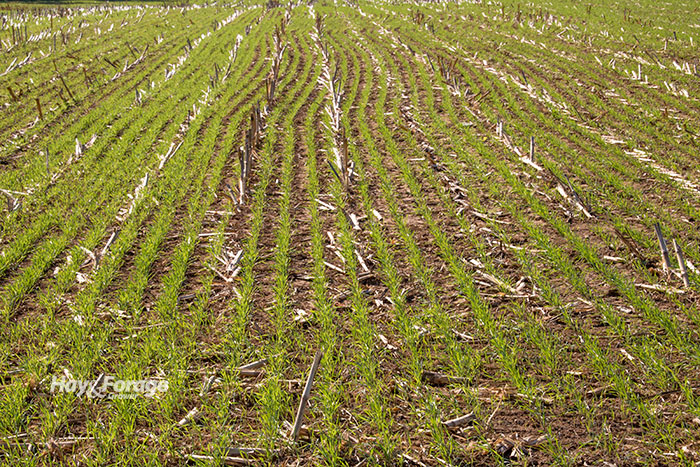Winter cereals offer value in dairy rations |
| By Mike Rankin, Managing Editor |
|
|
 Winter annual cereal crops provide beneficial soil cover through the late fall, winter, and spring, but they also are an excellent forage source that can be incorporated into dairy rations. “Double-cropping winter forage species to increase a dairy’s forage supply has become a popular strategy,” notes Sarah Potts, an extension dairy and beef specialist with the University of Maryland. “A winter annual double-cropping system allows producers to take advantage of the environmental benefits of cover crops while expanding and diversifying the forage inventory on their farm.” Winter rye, barley, and triticale are now routinely planted in the fall, often after a corn silage harvest, and then harvested in the spring before replanting the field to corn or some other annual crop. Potts says the moderate protein and neutral detergent fiber (NDF) content of winter cereals make them viable substitutes for portions of other forages in the diet. This can help extend the inventories of other forage sources such as corn silage. “Forage quality will have a big impact on how cows respond to these diet alterations,” Potts says. “For example, partial replacement of good-quality corn silage, having high starch and highly digestible NDF, with mediocre or poor-quality rye or triticale, having high NDF and undigestible NDF, may result in reduced performance, depending on the inclusion rate.” Average and acceptable range for forage quality components of various silage types.  Source: Dairy One Interactive Feed Composition Libraries Potts cites the results from a recent Pennsylvania study that investigated the effect of partial replacement of corn silage (41% NDF; 35% starch) with high-quality triticale silage (51% NDF; 17% CP) or wheat silage (51% NDF; 15% CP). The control cows that were fed the corn silage diet (44% of diet dry matter) produced 92 pounds of milk per day at 3.8% fat and 3% protein. Inclusion of 10% triticale silage or wheat silage as a replacement for some of the corn silage slightly reduced milk yield to 90 pounds per day but did not affect milkfat or protein concentrations. Although production was slightly reduced for cows fed triticale or wheat silage, Potts notes that the study demonstrates high-quality triticale or wheat silage can maintain a competitive level of production at partial substitution levels. Which species? Farmers often wrestle with the decision of which winter annual species will provide the most value or is best suited for their operation. Potts suggests addressing these three questions: How will the feed be utilized? “If you plan to use this crop to supplement the lactating cow diet, prioritize maximizing forage quality over yield,” Potts asserts. “For highest forage quality, harvest small grains in the early boot stage, or just prior to seedhead emergence.” Although yield increases significantly after the boot stage, forage quality and feeding value dramatically decline, making it unsuitable for a lactating cow ration. If the crop will be used to feed heifers or dry cows, a later harvest (soft-dough stage) can boost forage yield but with a moderate decline in quality. A later harvest will also delay the planting of a subsequent crop. Is spring weather conducive to the ideal harvest window? Forage quality declines with maturity, but the rate of decline will vary with species. “Wheat and triticale are somewhat forgiving because forage quality declines more gradually after it peaks at the early boot stage,” Potts explains. “In contrast, the forage quality of rye rapidly deteriorates after the boot stage, so harvest timing is much more critical if high-quality forage is desired. Wet conditions during the spring can make it difficult to get into the fields to achieve the ideal harvest window for maximum quality,” she adds. Can the cereal be planted on time? The ideal planting window for winter cereals generally varies according to the species’ winterhardiness. Barley is the least cold tolerant of the winter cereals and needs to be planted earlier in the fall to reduce the likelihood of winterkill. In contrast, rye is the most winterhardy of the cereals and can be planted into early November. |
